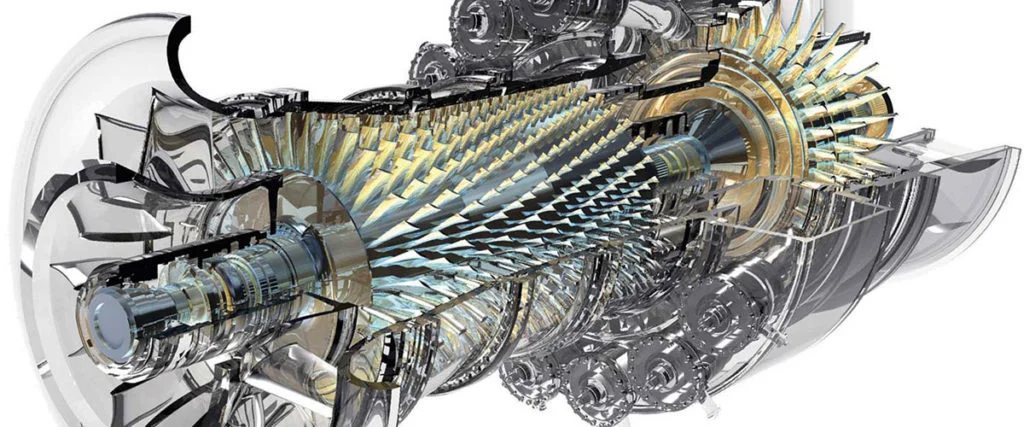Stationary Gas Turbine Emissions Calculator – US EPA AP-42

Photo from AutomationForum.co
What is a gas turbine?
A stationary gas turbine is a type of internal combustion engine that converts the kinetic energy of an expanding gas (the working fluid) into useable mechanical energy. The expanding gas is a mixture of air and fuel which is first compressed and then ignited. The combusted expanding gas is channelled through a chamber of rotating blades (the turbine) which are attached to an output shaft. The kinetic energy of the gas passing through the turbine transfers a portion of the kinetic energy to the blades which in turn cause the shaft to rotate. The mechanical energy which is transferred to the shaft can then be utilised for other purposes such as driving a generator, pump, propeller or even used as direct propulsion system (i.e. a jet engine).
What are typical gas turbine emissions?
Stationary gas turbines are a type of internal combustion engine, and therefore typical emissions are those associated with the combustion of fossil fuels. Emissions associated stationary gas turbine can be split into primary and secondary pollutants and greenhouse gases. Primary pollutants associated with stationary combustion turbines include:
- Nitrogen oxides or NOx
- Carbon monoxide or CO
- Particulate matter or PM (a primary pollutant for liquid fuel gas turbines)
Secondary pollutants are emitted in lower quantities and include:
- Volatile organic compounds or VOC
- Hazardous air pollutants or HAP
- Sulphur dioxide or SO2 (SO2 emissions are dependent on the sulphur content of the fuel)
Greenhouse gasses associated with stationary gas turbines include:
- Carbon dioxide or CO2
- Nitrous oxide N2O
How do we calculate emissions?
Emission factors are a simple and effective tool for the estimation of emissions. Emission factors are generally based on empirical relationships between equipment parameters and measured emission rates. These parameters can include fuel flow rates, thermal input, power output etc. The emission factors are multiplied by the specific equipment parameter resulting in an estimate quantity of emissions. If the input parameter (such is fuel flow rate) is for a given period of time, then the output is an emission rate over the given period of time (e.g. CO2 tonnes/annum). The following equation shows this:
Emissions (mass) = Emission Factor (mass/parameter unit) x Input Parameter
In the case of the AP-42 the emission factor units are lb/MMBtu, which means that for every unit of energy (MMBtu) input from the fuel there’s a corresponding mass (lb) of pollutant emitted.
E.g.
- Pollutant or GHG: CO2
- Emissions Control: Uncontrolled
- Fuel: Natural Gas
- Thermal/Fuel Input = 100,000 MMBtu/annum
Using information from 1, 2 and 3 we can get the Emission Factor in the US EPA AP-42:
CO2 Emission Factor = 110 lb/MMBtu
Therefore:
CO2 Emission Rate = 110 [lb/MMBtu] x 100,000 [MMBtu/annum] = 4,989.5 metric tonnes/annum
See out unit converter calculators at out Tools Room.
US EPA Emission Factors
The US Environmental Protection Agency (USEPA), which acts as an independent executive agency of the US federal government, is designated for environmental protection matters. The USEPA was founded to take responsibility for human health, the environment and to provide technical assistance in order to support public health and infrastructure.
Air quality and emissions most certainly fall under the scope of USEPA as these gases are potentially harmful to humans and the environment. The agency provides literature (AP-42) that sets out standardised methodology to quantify emissions for combustion sources by providing “Emission factors”. These factors are primarily based off empirical evidence to which they are ranked according to statistical confidence, with “A” being the most reliable and then working its way down alphabetically to “E” being the least reliable. AP-42 covers a wide range of equipment and situations with the tool below giving us emission inventories specifically for stationary gas turbines. The emission factors used for this tool were derived from the AP-42 chapter “Stationary Internal Combustion Sources” under the sub-heading “Stationary Gas Turbines”. The emission factors, through use of regression methods take a variety of parameters into account.
Comments and Suggestions
Is there an environmental engineering tool you would like to see at wkcgroup.com, or do you have recommendations on the tools we have? Please complete our online tools feedback form.

